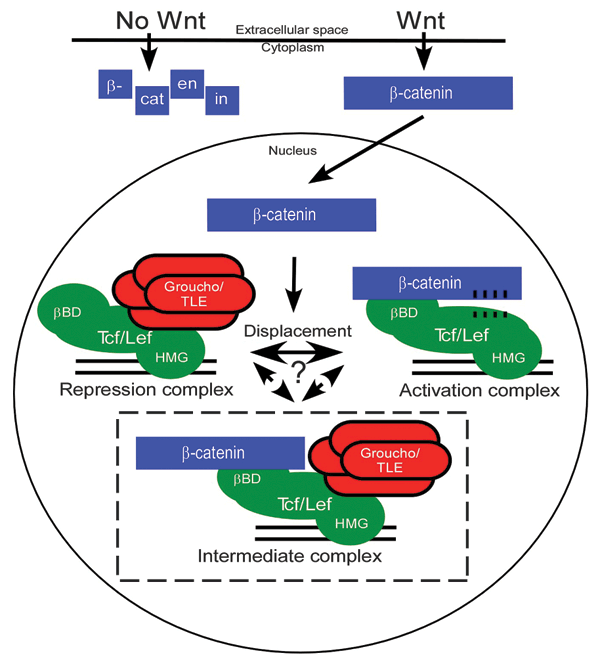
- Select a language for the TTS:
- UK English Female
- UK English Male
- US English Female
- US English Male
- Australian Female
- Australian Male
- Language selected: (auto detect) - EN
Play all audios:
ABSTRACT Wnt growth factors mediate cell fate determination during embryogenesis and in the renewal of tissues in the adult. Wnts act by stabilizing cellular levels of the transcriptional
coactivator β-catenin, which forms complexes with sequence-specific DNA-binding Tcf/Lef transcription factors. In the absence of nuclear β-catenin, Tcf/Lefs act as transcriptional repressors
by binding to Groucho/TLE proteins. The molecular basis of the switch from transcriptional repression to activation during Wnt signaling has not been clear, in particular whether factors
other than β-catenin are required to disrupt the interaction between Groucho/TLE and Tcf/Lef. Using highly purified proteins, we demonstrate that β-catenin displaces Groucho/TLE from Tcf/Lef
by binding to a previously unidentified second, low-affinity binding site on Lef-1 that includes sequences just N-terminal to the DNA-binding domain, and that overlaps the
Groucho/TLE-binding site. Access through your institution Buy or subscribe This is a preview of subscription content, access via your institution ACCESS OPTIONS Access through your
institution Subscribe to this journal Receive 12 print issues and online access $209.00 per year only $17.42 per issue Learn more Buy this article * Purchase on SpringerLink * Instant access
to full article PDF Buy now Prices may be subject to local taxes which are calculated during checkout ADDITIONAL ACCESS OPTIONS: * Log in * Learn about institutional subscriptions * Read
our FAQs * Contact customer support SIMILAR CONTENT BEING VIEWED BY OTHERS RNF2 REGULATES WNT/SS-CATENIN SIGNALING VIA TCF7L1 DESTABILIZATION Article Open access 13 November 2023
PROMOTER-PROXIMAL CTCF BINDING PROMOTES DISTAL ENHANCER-DEPENDENT GENE ACTIVATION Article 04 January 2021 RSPO2 INHIBITS TCF3 PHOSPHORYLATION TO ANTAGONIZE WNT SIGNALING DURING VERTEBRATE
ANTEROPOSTERIOR AXIS SPECIFICATION Article Open access 28 June 2021 REFERENCES * Cadigan, K.M. & Nusse, R. Wnt signaling: a common theme in animal development. _Genes Dev._ 11, 3286–3305
(1997). Article CAS PubMed Google Scholar * Bienz, M. & Clevers, H. Linking colorectal cancer to Wnt signaling. _Cell_ 103, 311–320 (2000). Article CAS PubMed Google Scholar *
Nusse, R. WNT targets: Repression and activation. _Trends Genet._ 15, 1–3 (1999). Article CAS PubMed Google Scholar * Hecht, A. & Kemler, R. Curbing the nuclear activities of
β-catenin. _EMBO Rep._ 1, 24–28 (2000). Article CAS PubMed PubMed Central Google Scholar * Aberle, H., Bauer, A., Stappert, J., Kispert, A. & Kemler, R. β-catenin is a target for
the ubiquitin-proteasome pathway. _EMBO J._ 16, 3797–3804 (1997). Article CAS PubMed PubMed Central Google Scholar * Amit, S. et al. Axin-mediated CKI phosphorylation of β-catenin at
Ser 45: a molecular switch for the Wnt pathway. _Genes Dev._ 16, 1066–1076 (2002). Article CAS PubMed PubMed Central Google Scholar * Behrens, J. et al. Functional interaction of an
Axin homolog, conductin, with β-catenin, APC, and GSK3β. _Science_ 280, 596–599 (1998). Article CAS PubMed Google Scholar * Hart, M.J., de los Santos, R., Albert, I.N., Rubinfeld, B.
& Polakis, P. Downregulation of β-catenin by human Axin and its association with the APC tumor suppressor, β-catenin, and GSK3β. _Curr. Biol._ 8, 573–581 (1998). Article CAS PubMed
Google Scholar * Orford, K., Crockett, C., Jensen, J.P., Weissman, A.M. & Byers, S.W. Serine phosphorylation-regulated ubiquitination and degradation of β-catenin. _J. Biol. Chem._ 272,
24735–24738 (1997). Article CAS PubMed Google Scholar * Rubinfeld, B. et al. Binding of GSK3β to the APC–β-catenin complex and regulation of complex assembly. _Science_ 272, 1023–1026
(1996). Article CAS PubMed Google Scholar * Behrens, J. et al. Functional interaction of β-catenin with the transcription factor LEF-1. _Nature_ 382, 638–642 (1996). Article CAS PubMed
Google Scholar * Brunner, E., Peter, O., Schweizer, L. & Basler, K. _pangolin_ encodes a Lef-1 homologue that acts downstream of Armadillo to transduce the Wingless signal in
_Drosophila_. _Nature_ 385, 829–833 (1997). Article CAS PubMed Google Scholar * Molenaar, M. et al. XTcf-3 transcription factor mediates β-catenin-induced axis formation in _Xenopus_
embryos. _Cell_ 86, 391–399 (1996). Article CAS PubMed Google Scholar * van de Wetering, M. et al. Armadillo coactivates transcription driven by the product of the _Drosophila_ segment
polarity gene _dTCF_. _Cell_ 88, 789–799 (1997). Article CAS PubMed Google Scholar * Korinek, V. et al. Constitutive transcriptional activation by a β-catenin–Tcf complex in APC−/− colon
carcinoma. _Science_ 275, 1784–1787 (1997). Article CAS PubMed Google Scholar * Morin, P.J. et al. Activation of β-catenin–Tcf signaling in colon cancer by mutations in β-catenin or
APC. _Science_ 275, 1787–1790 (1997). Article CAS PubMed Google Scholar * Rubinfeld, B., Albert, I., Porfiri, E., Munemitsu, S. & Polakis, P. Loss of β-catenin regulation by the APC
tumor suppressor protein correlates with loss of structure due to common somatic mutations of the gene. _Cancer Res._ 57, 4624–4630 (1997). CAS PubMed Google Scholar * Rubinfeld, B. et
al. Stabilization of β-catenin by genetic defects in melanoma cell lines. _Science_ 275, 1790–1792 (1997). Article CAS PubMed Google Scholar * Polakis, P. Wnt signaling and cancer.
_Genes Dev._ 14, 1837–1851 (2000). CAS PubMed Google Scholar * Hurlstone, A. & Clevers, H. T-cell factors: turn-ons and turn-offs. _EMBO J._ 21, 2303–2311 (2002). Article CAS PubMed
PubMed Central Google Scholar * Townsley, F.M., Thompson, B., Bienz, M. Pygopus residues required for its binding to Legless are critical for transcription and development. _J. Biol.
Chem._ 279, 5177–5183 (2004). Article CAS PubMed Google Scholar * Parker, D.S., Jemison, J., Cadigan K.M. Pygopus, a nuclear PHD-finger protein required for Wingless signaling in
_Drosophila_. _Development_ 11, 2565–2576 (2002). Google Scholar * Thompson, B., Townsley, F., Rosin-Arbesfeld, R., Musisi, H. & Bienz, M. A new nuclear component of the Wnt signalling
pathway. _Nat. Cell Biol._ 4, 367–373 (2002). Article CAS PubMed Google Scholar * Kramps, T. et al. Wnt/Wingless signaling requires BCL9/Legless-mediated recrutiment of pygopus to the
nuclear β-catenin–TCF complex. _Cell_ 109, 47–60 (2002). Article CAS PubMed Google Scholar * Hecht, A., Litterst, C.M., Huber, O. & Kemler, R. Functional characterization of multiple
transactivating elements in β-catenin, some of which interact with the TATA-binding protein _in vitro_. _J. Biol. Chem._ 274, 18017–18025 (1999). Article CAS PubMed Google Scholar *
Hsu, S.-C., Galceran, J. & Grosschedl, R. Modulation of transcriptional regulation by LEF-1 in response to Wnt-1 signaling and association with β-catenin. _Mol. Cell. Biol._ 18,
4807–4818 (1998). Article CAS PubMed PubMed Central Google Scholar * Hecht, A., Vleminckx, K., Stemmler, M.P., van Roy, F. & Kemler, R. The p300/CBP acetyltransferases function as
transcriptional coactivators of β-catenin in vertebrates. _EMBO J._ 19, 1839–1850 (2000). Article CAS PubMed PubMed Central Google Scholar * Daniels, D.L. & Weis, W.I. ICAT inhibits
β-catenin binding to Tcf/Lef-family transcription factors and the general coactivator p300 using independent structural modules. _Mol. Cell_ 10, 573–584 (2002). Article CAS PubMed Google
Scholar * Takemaru, K. & Moon, R.T. The transcriptional coactivator CBP interacts with β-catenin to activate gene expression. _J. Cell Biol._ 149, 249–254 (2000). Article CAS PubMed
PubMed Central Google Scholar * Tutter, A.V., Fryer, C.J. & Jones, K.A. Chromatin-specific regulation of LEF-1-β-catenin transcription activation and inhibition _in vitro_. _Genes
Dev._ 15, 3342–3354 (2001). Article CAS PubMed PubMed Central Google Scholar * Goodman, R.H. & Smolik, S. CBP/p300 in cell growth, transformation, and development. _Genes Dev._ 14,
1553–1577 (2000). CAS PubMed Google Scholar * Barker, N. et al. The chromatin remodelling factor Brg-1 interacts with β-catenin to promote target gene activation. _EMBO J._ 20, 4935–4943
(2001). Article CAS PubMed PubMed Central Google Scholar * Billin, A.N., Thirlwell, H. & Ayer, D.E. β-catenin-histone deacetylase interactions regulate the transition of LEF1 from a
transcriptional repressor to an activator. _Mol. Cell. Biol._ 20, 6882–6890 (2000). Article CAS PubMed PubMed Central Google Scholar * Brantjes, H., Roose, J., van de Wetering, M.
& Clevers, H. All Tcf HMG box transcription factors interact with Groucho-related co-repressors. _Nucleic Acids Res._ 29, 1410–1419 (2001). Article CAS PubMed PubMed Central Google
Scholar * Cavallo, R.A. et al. _Drosophila_ Tcf and Groucho interact to repress Wingless signalling activity. _Nature_ 395, 604–608 (1998). Article CAS PubMed Google Scholar * Roose, J.
et al. The _Xenopus_ Wnt effector XTcf-3 interacts with Groucho-related transcriptional repressors. _Nature_ 395, 608–612 (1998). Article CAS PubMed Google Scholar * Chen, G. &
Courey, A.J. Groucho/TLE family proteins and transcriptional repression. _Gene_ 249, 1–16 (2000). Article CAS PubMed Google Scholar * Courey, A.J. & Jia, S. Transcriptional
repression: the long and short of it. _Genes Dev._ 15, 2786–2796 (2001). CAS PubMed Google Scholar * Fisher, A.L. & Caudy, M. Groucho proteins: transcriptional corepressors for
specific subsets of DNA-binding transcription factors in vertebrates and invertebrates. _Genes Dev._ 12, 1931–1940 (1998). Article CAS PubMed Google Scholar * Narlikar, G.J., Fan, H.-Y.
& Kingston, R.E. Cooperation between complexes that regulate chromatin structure and transcription. _Cell_ 108, 475–487 (2002). Article CAS PubMed Google Scholar * Waltzer, L. &
Bienz, M. _Drosophila_ CBP represses the transcription factor TCF to antagonize Wingless signalling. _Nature_ 395, 521–525 (1998). Article CAS PubMed Google Scholar * Stifani, S.,
Blaumueller, C.M., Redhead, N.J., Hill, R.E. & Artavanis-Tsakonas, S. Human homologs of a _Drosophila_ enhancer of split gene product define a novel family of nuclear proteins. _Nat.
Genet._ 2, 119–127 (1992). Article CAS PubMed Google Scholar * Pinto, M. & Lobe, C.G. Products of the grg (Groucho-related gene) family can dimerize through the amino-terminal Q
domain. _J. Biol. Chem._ 271, 33026-33031 (1996). * Chen, G., Nguyen, P.H., Courey, A.J. A role for groucho tetramerization in transcriptional repression. _Mol. Cell. Biol._ 18, 7259–7268
(1998). Article CAS PubMed PubMed Central Google Scholar * Song, H., Hasson, P., Paroush, Z., Courey, A.J. Groucho oligomerization is required for repression _in vivo_. _Mol. Cell.
Biol._ 24, 4341–4350 (2004). Article CAS PubMed PubMed Central Google Scholar * Graham, T.A., Ferkey, D.M., Mao, F., Kimelman, D. & Xu, W. Tcf4 can specifically recognize β-catenin
using alternative conformations. _Nat. Struct. Biol._ 8, 1048–1052 (2001). Article CAS PubMed Google Scholar * Graham, T.A., Weaver, C., Mao, F., Kimmelman, D. & Xu, W. Crystal
structure of a β-catenin/Tcf complex. _Cell_ 103, 885–896 (2000). Article CAS PubMed Google Scholar * Poy, F., Lepourcelet, M., Shivdasani, R.A. & Eck, M.J. Structure of a human
Tcf4–β-catenin complex. _Nat. Struct. Biol._ 8, 1053–1057 (2001). Article CAS PubMed Google Scholar * van de Wetering, M., Oosterwegel, M., Dooijes, D., Clevers, H. Identification and
cloning of TCF-1, a T cell-specific transcription factor containing a sequence-specific HMG box. _EMBO J._ 10, 123–132 (1991). Article CAS PubMed PubMed Central Google Scholar * Love,
J.J., Li, X., Chung, J., Dyson, H.J., Wright, P.E. The Lef-1 high mobility group domain undergoes a disorder-to-order transition upon formation of a complex with cognate DNA. _Biochemistry_
43, 8725–8734 (2004). Article CAS PubMed Google Scholar * Schweizer, L., Nellen, D., Basler, K. Requirements for Pangolin/dTCF in _Drosophila_ Wingless signaling. _Proc. Natl. Acad. Sci.
USA_ 100, 5846–5851 (2003). Article CAS PubMed PubMed Central Google Scholar * Roose, J. et al. Synergy between tumor suppressor _APC_ and the β-catenin-Tcf4 target _Tcf1_. _Science_
285, 1923–1926 (1999). Article CAS PubMed Google Scholar * Huber, A.H., Nelson, W.J. & Weis, W.I. Three-dimensional structure of the armadillo repeat region of β-catenin. _Cell_ 90,
871–882 (1997). Article CAS PubMed Google Scholar * Yang, W., Steitz, T.A. Crystal structure of the site-specific recombinase γ δ resolvase complexes with a 34bp cleavage site. _Cell_
82, 193–207 (1995). Article CAS PubMed Google Scholar * Love, J.J. et al. Structural basis for DNA bending by the architectural transcription factor LEF-1. _Nature_ 376, 791–795 (1995).
Article CAS PubMed Google Scholar Download references ACKNOWLEDGEMENTS We thank M. Boulanger for assistance with the MALLS analysis, H.-J. Choi for the ITC data, S. Frydman for technical
assistance and S. Stifani for TLE cDNAs. The tryptic peptide mapping was carried out by the Protein and Nucleic Acid Facility at Stanford University School of Medicine and mass spectrometry
was done at the Molecular Structure Facility at University of California, Davis. This work was supported by grant GM56169 from the US National Institutes of Health to W.I.W. AUTHOR
INFORMATION AUTHORS AND AFFILIATIONS * Departments of Structural Biology and of Molecular & Cellular Physiology, Stanford University School of Medicine, Stanford University School of
Medicine, 299 Campus Drive West, Stanford, 94305-5126, California, USA Danette L Daniels & William I Weis Authors * Danette L Daniels View author publications You can also search for
this author inPubMed Google Scholar * William I Weis View author publications You can also search for this author inPubMed Google Scholar CORRESPONDING AUTHOR Correspondence to William I
Weis. ETHICS DECLARATIONS COMPETING INTERESTS The authors declare no competing financial interests. SUPPLEMENTARY INFORMATION SUPPLEMENTARY FIG. 1 MALLS analysis. (PDF 336 kb) SUPPLEMENTARY
FIG. 2 ITC data. (PDF 164 kb) SUPPLEMENTARY TABLE 1 MALLS molecular mass. (PDF 60 kb) RIGHTS AND PERMISSIONS Reprints and permissions ABOUT THIS ARTICLE CITE THIS ARTICLE Daniels, D., Weis,
W. β-catenin directly displaces Groucho/TLE repressors from Tcf/Lef in Wnt-mediated transcription activation. _Nat Struct Mol Biol_ 12, 364–371 (2005). https://doi.org/10.1038/nsmb912
Download citation * Received: 04 October 2004 * Accepted: 08 February 2005 * Published: 13 March 2005 * Issue Date: 01 April 2005 * DOI: https://doi.org/10.1038/nsmb912 SHARE THIS ARTICLE
Anyone you share the following link with will be able to read this content: Get shareable link Sorry, a shareable link is not currently available for this article. Copy to clipboard Provided
by the Springer Nature SharedIt content-sharing initiative







